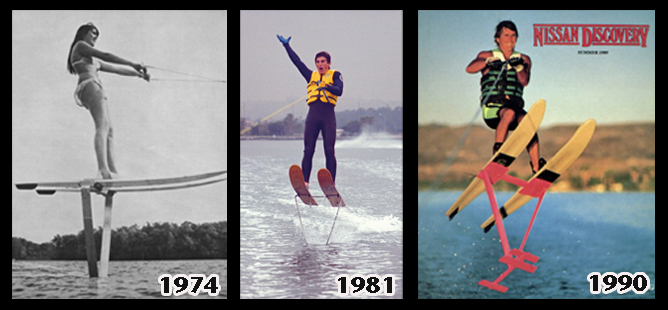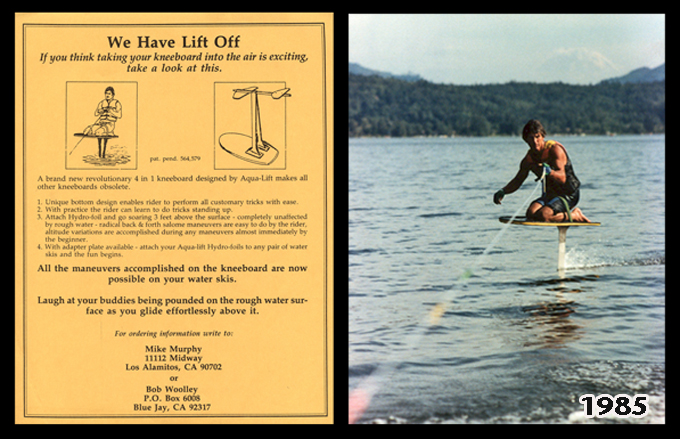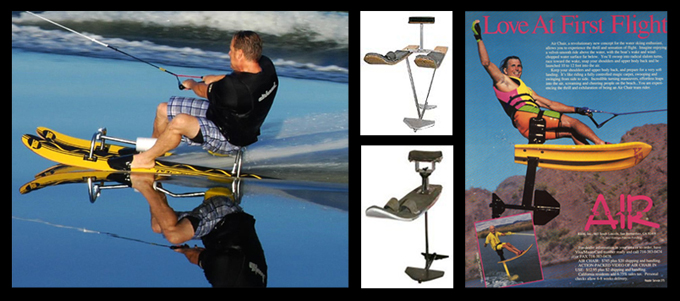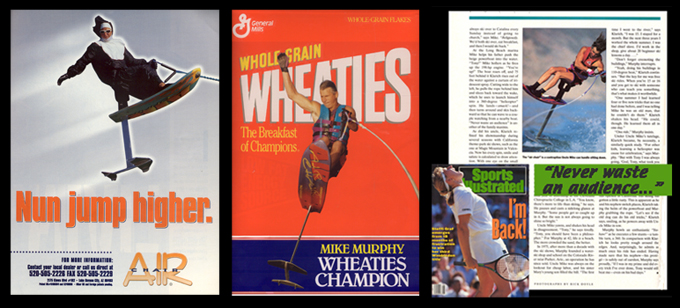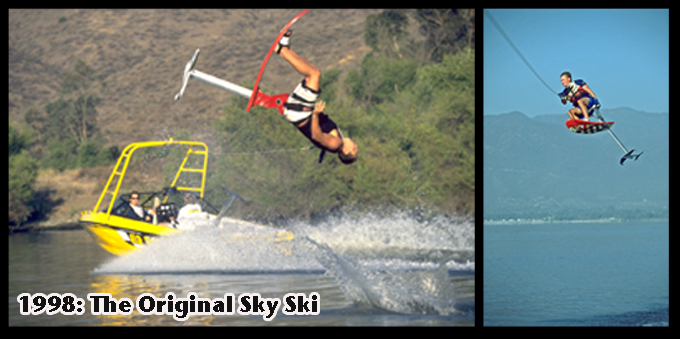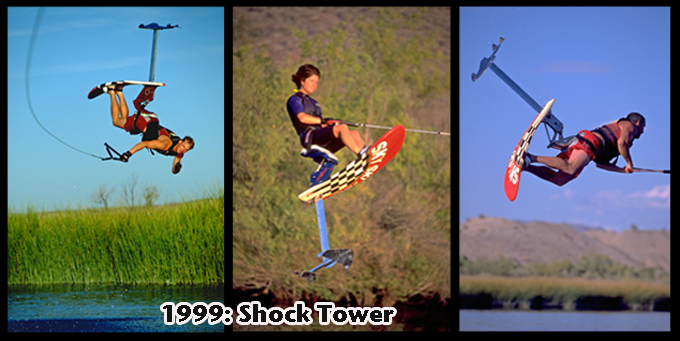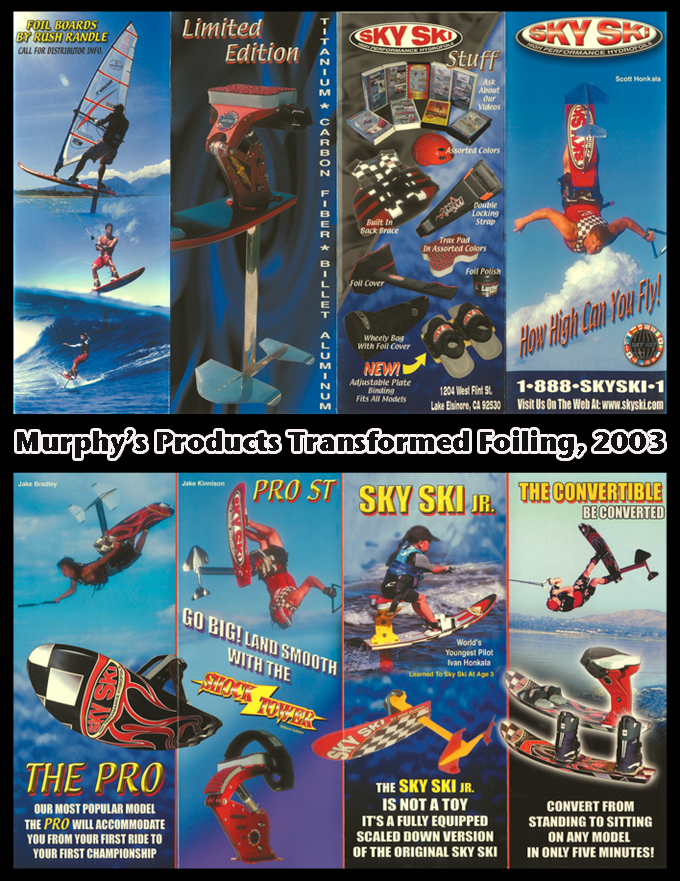To My Fellow Foilers,
I have been hydrofoiling for nearly 50 years, and I would like to take some time to share my experiences with you.
My first ride on stand up foils was in 1966. I had just graduated from high school and spent the summer as a water ski instructor on Lake Arrowhead, CA. It was there that I ran into an “old” guy (he must have been 50) with a pair up stand up foils who taught me how to ride. I got up on my first try, flew around the lake, and ever since then riding foils has been my passion.
STAND UP HYDROFOIL
In the late 1960s and early 1970s I worked as a professional show skier during the summers. Unfortunately no one rode foils at the shows, so I had to wait until the off-season to get my foiling fix. My dad put together a pair of stand up foils with wooden skis for our frequent family trips to the Long Beach Marine Stadium in Southern California. The small site with constant crowds made it the perfect ski spot for “showtime”. As the jumps got bigger, the equipment started breaking so my dad added stainless steel guy wires for extra support. Now I could push things further, and ended up in jumping contests with my nephew Tony Klarich. It usually took more than 20 consecutive wake-to-wake jumps with a 75-foot line to claim victory for the day.
In 1976 I opened a ski school on the Parker Strip of the Colorado River, and stand up foils became a part of my daily riding. They were perfect for the afternoon wind and chop. My ski shop rented them and I often gave lessons to people who saw us flying on the river. I even taught future industry co-founder Bob Woolley how to ride. As I got better and pushed the equipment far beyond what it was originally intended to do, it became obvious that I had to find new materials and means of manufacturing to withstand the pressures of even bigger jumps. After teaching Buck Buxton how to ride, he got hooked on foiling too. Together we redesigned the foils in the late 1980s to create the best design for stand up foils at that time.
KNEEBOARD HYDROFOIL
I had a dock full of rental equipment at my ski school, and was always trying to find new ways to ski. Around 1984 I decided to combine my first invention (kneeboard, 1972) with my latest stand up foils. Again I experimented with design, and even used the single strut foil that I made with Buck. The kneeboard hydrofoil worked well, and soon Bob Woolley and I teamed up in 1985 to develop the product. Eventually we sold our new way to ride to Kransco, maker of Hula-Hoops and Hydroslides. In the mid 1980s kneeboarding was the hottest thing in water skiing, and Kransco was leading the charge with their Hydroslides. Unfortunately our kneeboard hydrofoil never got into production, and we had signed a confidentiality clause with Kransco saying we would not ride the device for several years.
Bob and I had to find another way to ride foils. One of the things I rented at my ski school was called a Ski Seat. It consisted of two skis with bindings and a low seat. The Ski Seat was held together by a series of articulated bent tubes. You sat down on it, put your feet in the bindings, and the skis pivoted while you turned. Woolley loved to ride the Ski Seat and used the 2-ski sit down design as an inspiration. He built something similar to the Ski Seat, but it was fixed and did not pivot. Then he mounted it onto a pair of stand up foils. His new contraption worked well right from the start. I tired it too, but the first thing I noticed was the water slapping me in the gonads! After that first ride I told Bob he should push the two skis together to make a single board. Bob did the building and I offered suggestions. The design improved over the next few months. One day I was jumping and lost control (it was a real adventure without a seatbelt or heelstraps). I came completely off the ski and cut my arm real bad. On my next ride I added a car seatbelt to stay attached. Not only was it safer, but my jumps got way bigger. Bob and I filed for patents and continued to improve the sit down hydrofoil as we prepared for production.
AIR CHAIR
We called our new ride the Sky Ski and it was even featured in the National Enquirer. I chose the name based on my show skiing experiences at the Tommy Bartlett’s Ski Sky and Stage Shows, but Bob had second thoughts on the name and changed it to Air Chair. It wasn’t long before our new invention became a real sport. For me it was time to hit the boat show circuit again in winter, and hit the road for clinics and demos during the summers. Hydrofoiling became a big hit. After I started riding out the first flips in 1990, and teaching other riders how to flip too, there was no stopping the attention we drew. It was commonplace to have boats make a U-turn and follow us for miles while we performed big jumps, spins, and rolls. The Air Chair became a media magnet, and I was the front man. My years as a show skier and numerous connections in the water skiing industry helped big time. There were hundreds of magazine articles, TV appearances, and more. I was fortunate to appear riding on the pages of Sports Illustrated (1991), and even on the pages of Playboy (1995).
I was living the dream of a water skier, traveling the world to promote our new sport, and making a decent living along the way. And all the while it was Bob who was back at the Air Chair factory holding down the fort with most of the day-to-day operations and business decisions. We were a successful team, and sold thousands of Air Chairs around the world. But even though things were going so well, my desire for invention and innovation was overpowering. The design changes couldn’t come quickly enough for me. Whenever I had a new idea, I wanted to immediately implement it to improve the performance and durability of the Air Chair. But Bob was satisfied with a slow and steady pace of R&D. He countered that our current product was selling, and we were the only game in town. I wanted to sacrifice some profits for rapid research and development, but Bob wanted to maximize profits and keep things in slow motion. It hadn’t been our only disagreement and our partnership ended in divorce. I was no longer an owner of Air Chair, but did retain the right to produce sit down hydrofoils as the co-holder of the patents.
SKY SKI
In 1998 I founded Sky Ski, and was finally free to implement years of my performance improving ideas. It was time to see how far I could take foiling.
I added a keel to the bottom of my t-bar to give it strength for higher jumps. Next, I got to work on the wings. My new rear wing completely reversed the angle of attack to improve stability. It virtually eliminated the need to raise your hands up and down to control altitude. It was such an improvement that I filed for a patent. I reshaped the front wings and made them considerably larger to increase lift and allow for higher jumps. I worked towards streamlining, strengthening, and refining my foil designs and kept experimenting to see how different sizes and shapes affected the performance.
One of my first projects at Sky Ski was to upgrade from the plastic seat tower we used at Air Chair. Riders needed something larger and stronger. We were jumping nearly 20 feet high and the standard equipment of the day wasn’t holding up. With my background in aluminum it made sense to try and build a tower out of that.
The new Sky Ski tower was made of two aluminum side plates, and a top plate for the seat. At first I tried welding the plates together, but ran into problems. When you weld aluminum it destroys the heat treat in the surrounding area. The only way to get the stiffness back into the welded aluminum was by reheat treating. But during that process the material bends, and then has to be straightened. It was nearly impossible to keep any consistency. With all these extra steps it made sense to get rid of the welding and hold the tower together by using stainless steel fasteners.
There were other improvements too. I angled my new tower forward and added 2 inches to the front of the seat. That made for softer landings because the load during touchdown was spread over a larger area. The increased area toward the front of the ski also made it easier for beginners. Now they could move their center of gravity further forward to help keep the ski on the water in the taxi position. My new “Rock Tower” was 6061-T6 aluminum and was formed (bent) to shape. Mission accomplished.
As the durability of my new Sky Skis grew, so did the performance. And these better performances left riders wanting even softer landings. It took months to develop the first the Shock Tower, which utilized a mountain bike shock to dampen the landings. It was a real breakthrough at the time, but fairly heavy. As always I kept at the incremental improvements, constantly finding ways to cut down the weight and eliminate as many moving parts as possible.
It was also my mission to expand the line, so I introduced the Sky Ski Jr. just for kids. My love of new ways to ride led to the development and release of the “Convertible”: a board that could be ridden sitting down or converted to ride standing up like a wakeboard. (I actually taught Laird Hamilton and his wife Gabriel Reese how to ride sit down foils in the late 1990s. Later I supplied him with foils for his stand up board which he rode surf style on enormous waves after being towed in by personal watercraft.) I invested money back into the sport with ongoing product development, a large contingent of team riders, and financial support for projects like the MasterCraft Flight Worlds, the Pro Hydrofoil Tour, and Flight Worlds Newsletter.
In the early days of Air Chair and Sky Ski we used 356-A aluminum to cast the t-bars as one solid piece (some price point foils are still made using cast aluminum). The problem is that cast parts (including wings) are just not that strong and the metal itself is porous and has too many inconsistencies. That was fine for beginners who aren’t pushing their equipment, but I wanted to make high-end foils for maximum performance. For me that meant a streamlined strut and fuselage that was still strong enough to take the abuse of big air landings. Sky Ski team riders were using my improved equipment to launch 20-25 foot high jumps, and their cast aluminum foils weren’t standing up, even with the new keel. My search for stronger materials led me to Don Erb at Compech. He was a hydrofoiler who made Indy car engines and was very knowledgeable in materials. Our discussions about what to use resulted in a try with 6061-T6 aircraft grade billet aluminum. The new 1-piece t-bars were machined out of a solid block of aluminum on a CNC machine at his shop.
It was a pricey operation, and there was lots of wasted aluminum, but the results were spectacular. I started making my wings using this new process too. Everything had been completely redone and I called my new Sky Ski the LE for Limited Edition. It was a surprise hit, and high performance riders willingly paid a premium price for my strongest and best performing hydrofoil to date.
The LE surpassed all my expectations, but that didn’t stop me from searching for even more improvements. The new 1-piece solid aluminum t-bars made on the CNC machine were three times stronger, but ten times more expensive. So now I needed to find an affordable way to use solid aluminum in my t-bars for the mass public.
My search led me to the process of extrusion where heated metal is pushed through a form, but this was possible only if the strut and fuselage were made individually. I moved forward with extrusion, and one again faced the difficulties of welding aluminum parts together. Welding the extruded strut and fuselage together was time consuming, but it allowed me to use more expensive materials to produce a much better product at a reduced price. I got rid of my cast molds and all the associated headaches with tuning, testing, and warranty.
Things were going well at Sky Ski, and I was spending a lot of time working with Don Erb who was contracted to make my Limited Edition aluminum parts. One thing led to another and we started talking about Compech taking over Sky Ski. I was ready to move away from the day-to-day responsibility of running a successful company, and in 2004 the sale became official.
It wasn’t long before Don Erb found a way to avoid welding the 2-piece billet bars. He used stainless fasteners to hold the strut and fuselage together, just as I had done with my original Rock Tower.
In looking back on my time owning and operating Sky Ski, one of my most substantial accomplishments was the patent I received for means and manufacturing of a 2-piece billet t-bar (strut + fuselage).
With lots of free time, and my mind constantly at work, I turned to the development of new watersports products such as the PureVert wake ballast system, Power Tower collapsible boat tower, Air Sling, and several other ideas. Through it all I never stopped foiling or thinking about ways to improve the sport.
NEXT FOILS
I enjoyed the time off, but eventually my covenant not to compete with Sky Ski expired. My days of royalties from Sky Ski were over too, and not being a rich man, I returned to what I know best…hydrofoils.
I had several ideas to take hydrofoiling to the next level of performance, so I chose Next Foils as my company name. I am back with a fire in my belly, hard at work, and once again dedicated to producing the best product possible.
My biggest breakthrough so far is to incorporate 7075 aircraft grade billet aluminum into the 2-piece billet bar. Doing this gives my new bar the strength of the 1-piece billet bar, but at a significantly reduced retail price. This new strut will provide my customers with a high-end aftermarket opportunity that will fit into most manufacturers’ high performance skis.
Like my first days at Sky Ski, one of my first priorities was to redesign the Next Foils seat tower. The next generation of foilers needs a better seat to stand up to additional air and stresses. Just like I did with my transition from Air Chair to Sky Ski, I have increased the surface area of the seat top to disperse landing loads over an even larger area. The key piece to the new tower is the “Carbon Spring”. It’s made of a carbon fiber – Kevlar composite and the oval shape allows it to flex during landings, and this is why it’s named the “Flex Tower” (patent pending). The Carbon Spring sits directly beneath my seat pad. My longtime goal to provide maximum cushion during landings while reducing the weight and moving parts has led to my best tower ever.
My decks have undergone years of testing and use because they are currently being manufactured by Sky Ski. Fortunately I still have a good working relationship with Don Erb, and I license Sky Ski my means and manufacturing patents on the two-piece billet bar. If all this isn’t enough, I have even more new ideas in the works and will be rolling them out as Next Foils starts to grow.
In closing I would like to say that there have been many people who have helped me turn my visions of new products into realities. Thanks to you all…
Peter Schörno, the late great Herb O’Brien, Tony Klarich, Mike Mack, Jake Kinnison, Don Erb, Wayne and Bruce Rexwinkle, and many of my engineering minded customers.
If you need a foil, I am your man.
Mike Murphy
June, 2013
For those interested in a more complete history of hydrofoiling as told by Mike’s nephew, you can download the interactive ebook for FREE at
There’s scores of photos and links to videos that bring the history of hydrofoiling to life.

